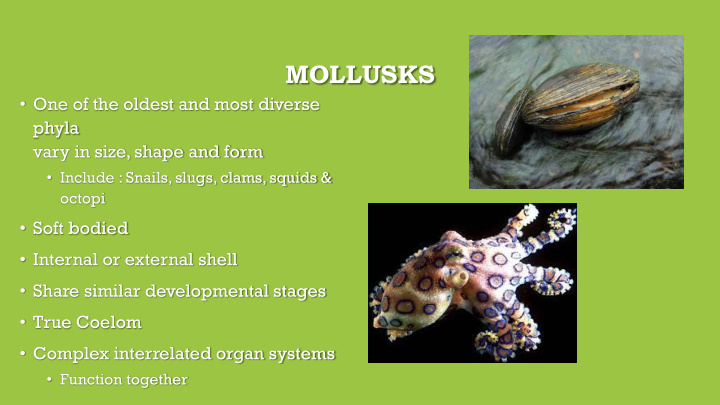



MOLLUSKS • One of the oldest and most diverse phyla vary in size, shape and form • Include : Snails, slugs, clams, squids & octopi • Soft bodied • Internal or external shell • Share similar developmental stages • True Coelom • Complex interrelated organ systems • Function together
DEVELOPMENT • Free swimming larval stage • Trochophore • Also characteristic of annelids • Shows relation • Shared a common anscestor 550 mya
FORM AND FUNCTION • Body plan • The body plan of most mollusks has four parts: foot, mantle, shell, and visceral mass. • Foot: takes many forms • Mantle • Thin layer of tissue covering most of the mollusks body • Shell • Made by glands in the mantle that secrete calcium carbonate • Has been reduced or lost in some mollusk groups (slugs) • Visceral mass • Below mantle, contains internal organs
BODY PLAN • The muscular foot takes many forms • flat structures for crawling • spade-shaped structures for burrowing • tentacles for capturing prey
FEEDING • Mollusks can be • Herbivores • Carnivores • Filter feeders • Detritivore • Parasites
FEEDING • Snails and slugs feed using a flexible, tongue-shaped structure known as a radula. • Hundreds of tiny teeth are attached to the radula. • The radula is used to scrape algae off rocks or to eat the soft tissues of plants. • Carnivorous mollusks use their radula to drill through shells to get at soft tissue
• Use sharp jaws • Octopi and certain sea slugs • Feathery gills • Food is carried by water • Enters incurrent siphon • Tubelike structure in which water enters the body • The water flows over the gills and leaves by the excurrent siphon. • Clams oysters and scallops
Recommend
More recommend